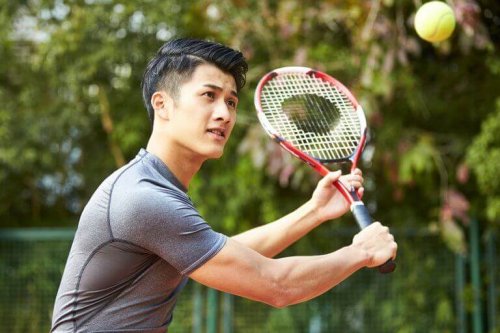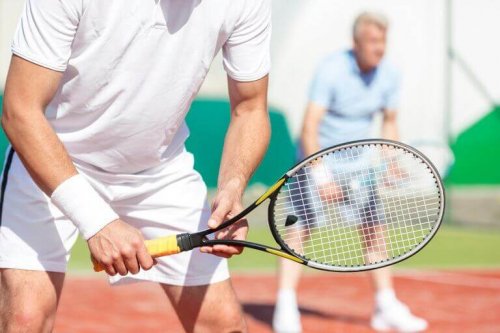Differences Between Tennis Doubles and Tennis Singles

If you’ve ever played tennis, you know perfectly well that singles tennis and doubles tennis are two entirely different games. Read on to learn about the main differences between these two.
Tennis, just like some other sports, gives the opportunity to play alone or with a partner. Given the choice, there are tennis players who do much better when playing singles. This is a very intriguing topic. So what are the differences and similarities between playing doubles and singles? Find out below.
Let’s observe the ranking of the doubles of the ATP ( Association of Professional Tennis Players). We’ll find that none of the players in the first positions is an outstanding player in the individual ratings.
There are two explanations for this. First, and most obvious is that those who excel in singles don’t tend to participate in the doubles contests. Furthermore, if they excel occasionally, they choose to drop out of doubles when they advance considerably in singles.
However, this is also related to the notable differences in the game of doubles versus singles. In the following, we’ll go over how both of these match types differ in rules and tactics.
The rules in doubles and singles tennis
Evidently, the most important difference between the two has to do with the boundaries of the court. In order to play doubles, the sidelines are wider, except when serving. Normally, the wider lines aren’t used in singles. So the width of the singles court is 27 feet and the width of the doubles court is 36 feet.
There’s a change in the placement of the net. The height will now be 3 and 1/2 feet at most and 3 feet in the middle of the net and applies to both ways of playing.
On the other hand, for singles, the posts for the net will be located one yard outside of the boundary lines for singles. Also, in doubles, they’re located at that distance outside the doubles line.

The serve will always follow the same order during the set. In other words, the player will start serving at the beginning of the first set. While the partner will serve in the third game of that set. At the same time, that player will serve in the initial game of the third set.
Finally, it’s important to note, that players who receive the serve can’t change positions when their rival is serving. However, once that ball crosses the net, players are free to move in the court whichever way is most effective for them.
Strategies of tennis doubles and singles
A difference in singles is that the free space is much more extensive. Whereas, in pairs, it’s a game of strategy to gain more territory. The space in the court needs to be covered less. This turns into an offensive priority to attack the rival in a more effective manner.
The hits that dominate this game are the ones that originate from the back of the court that go deep. This way, the player that hits the ball will get the point if the other one is close to the net.
With respect to the physical demands, singles and doubles are different. While in singles, players need to be aggressive, speedy and strong, in doubles it’s the location in the court. Also important in doubles is to be patient and good at volleying. Understanding and communicating with your partner are also vital in doubles.
Characteristics of players
In a singles game, each player alone must figure out what to do in situations. Their strengths, both physical and mental are all that they have to deal with circumstances that may develop.

In contrast, playing in doubles allows support from the partner. Ideally, the partner will have complementary qualities that mesh well with the style of the other player. For example, if I’m a good defensive player, it’ll be a big help if my partner is more aggressive and scores points.
As we can see, the strategy in tennis doubles begins before the game. Choosing a partner is an important tactic. It’s as important as anything that can be done on the court.
Finally, the mental component shouldn’t be ignored. In this aspect, we should look for a balance. Therefore, in the case that a player is temperamental and has a tendency to give up because of a mistake, it’s good to have a partner who is able to calm the player. This will help to get back on the path in a positive way.
If you’ve ever played tennis, you know perfectly well that singles tennis and doubles tennis are two entirely different games. Read on to learn about the main differences between these two.
Tennis, just like some other sports, gives the opportunity to play alone or with a partner. Given the choice, there are tennis players who do much better when playing singles. This is a very intriguing topic. So what are the differences and similarities between playing doubles and singles? Find out below.
Let’s observe the ranking of the doubles of the ATP ( Association of Professional Tennis Players). We’ll find that none of the players in the first positions is an outstanding player in the individual ratings.
There are two explanations for this. First, and most obvious is that those who excel in singles don’t tend to participate in the doubles contests. Furthermore, if they excel occasionally, they choose to drop out of doubles when they advance considerably in singles.
However, this is also related to the notable differences in the game of doubles versus singles. In the following, we’ll go over how both of these match types differ in rules and tactics.
The rules in doubles and singles tennis
Evidently, the most important difference between the two has to do with the boundaries of the court. In order to play doubles, the sidelines are wider, except when serving. Normally, the wider lines aren’t used in singles. So the width of the singles court is 27 feet and the width of the doubles court is 36 feet.
There’s a change in the placement of the net. The height will now be 3 and 1/2 feet at most and 3 feet in the middle of the net and applies to both ways of playing.
On the other hand, for singles, the posts for the net will be located one yard outside of the boundary lines for singles. Also, in doubles, they’re located at that distance outside the doubles line.

The serve will always follow the same order during the set. In other words, the player will start serving at the beginning of the first set. While the partner will serve in the third game of that set. At the same time, that player will serve in the initial game of the third set.
Finally, it’s important to note, that players who receive the serve can’t change positions when their rival is serving. However, once that ball crosses the net, players are free to move in the court whichever way is most effective for them.
Strategies of tennis doubles and singles
A difference in singles is that the free space is much more extensive. Whereas, in pairs, it’s a game of strategy to gain more territory. The space in the court needs to be covered less. This turns into an offensive priority to attack the rival in a more effective manner.
The hits that dominate this game are the ones that originate from the back of the court that go deep. This way, the player that hits the ball will get the point if the other one is close to the net.
With respect to the physical demands, singles and doubles are different. While in singles, players need to be aggressive, speedy and strong, in doubles it’s the location in the court. Also important in doubles is to be patient and good at volleying. Understanding and communicating with your partner are also vital in doubles.
Characteristics of players
In a singles game, each player alone must figure out what to do in situations. Their strengths, both physical and mental are all that they have to deal with circumstances that may develop.

In contrast, playing in doubles allows support from the partner. Ideally, the partner will have complementary qualities that mesh well with the style of the other player. For example, if I’m a good defensive player, it’ll be a big help if my partner is more aggressive and scores points.
As we can see, the strategy in tennis doubles begins before the game. Choosing a partner is an important tactic. It’s as important as anything that can be done on the court.
Finally, the mental component shouldn’t be ignored. In this aspect, we should look for a balance. Therefore, in the case that a player is temperamental and has a tendency to give up because of a mistake, it’s good to have a partner who is able to calm the player. This will help to get back on the path in a positive way.
All cited sources were thoroughly reviewed by our team to ensure their quality, reliability, currency, and validity. The bibliography of this article was considered reliable and of academic or scientific accuracy.
- ITF Reglas del tenis. 2017. International Tennis Federation. https://www.itftennis.com/media/136150/136150.pdf
This text is provided for informational purposes only and does not replace consultation with a professional. If in doubt, consult your specialist.








